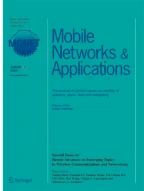Avoid common mistakes on your manuscript.
1 Foreword
This special issue, with six papers invited and extended from selected contributions to The 4th International Conference on Context-Aware Systems and Applications (ICCASA 2015) held in Vung Tau City of Vietnam, will serve as a reference material for researchers, scientists, professionals and students in computer science and computer engineering as well as developers and practitioners in computing and networking systems design by providing them with state-of-the-art research findings and future opportunities and trends. These papers include some various aspects of context-awareness reflected in this special issue. In particular, the special issue covers various contributions of context-awareness as follows:
-
Paper 1 by Ijaz Uddin, Abdur Rakib and Hafiz Mahfooz Ul Haque presents a systematic framework to modelling and implementation of resource-bounded multi-agent context-aware systems on Android devices. The proposed framework makes use of semantic technologies for context modelling and reasoning about resource-bounded context-aware agents, Android powered smartphones as development platform, a suitable communication model and declarative rule-based programming as a preferred development language.
-
Paper 2 by Alistair Morris, Constantinos Patsakis, Melanie Bouroche and Vinny Cahill describes Adaptive Context Tries (ACT), a decentralised context dissemination middleware that balances message transmission and control overhead to support urban-scale context-aware applications. ACT achieves scalability using a dynamically constructed virtual overlay, structured as a retrieval tree (trie) on node identifiers (IDs), avoiding continuous overlay rebuilds due to mobility or nodes changes by removing the need for subscriptions. Through formal analysis and extensive large-scale simulations authors show that unlike existing context dissemination algorithms ACT can handle dynamic context requirements in urban-scale scenarios.
-
Paper 3 by Wanling Xie, Huibiao Zhu, Xi Wu, Shuangqing Xiang, Jian Guo and Phan Cong Vinh uses Communicating Sequential Processes (CSP) to model and analyze Hadoop Distributed File System (HDFS). Authors mainly focus on the dominant parts which include reading files and writing files in HDFS and formalize them in detail. Moreover, authors also model the heartbeat mechanism. Finally, authors use the model checker Process Analysis Toolkit (PAT) to simulate the model constructed and verify whether it caters for the specification and some important properties, which include Deadlock-freeness, Minimal Distance Scheme, Mutual Exclusion, Write-Once Scheme and Robustness.
-
Paper 4 by Francesco Piccialli and Angelo Chianese presents a Internet of Things (IoT) context-aware system and its application in the Cultural Heritage domain. Cultural Heritage is a domain where the widespread diffusion of ICT technology and sensors, within its spaces like museums, art exhibition, etc., can strongly enhance the quality of the offered services and subsequently create a Smart Cultural Environment.
-
Paper 5 by A. Drif, A. Boukerram, Y. Slimani and S. Giordano considers to discover communities of mobile users and studying how do communities provide accurate knowledge to analysis the different forms of human mobility. Basic idea of the work is to model the behaviour of users with strong social characteristics regarding the context of their location histories to explore a similar interest of people by mining their mobiles communities. The proposed analysis illustrates in what way a common interest of a group of individuals can create better understanding of human mobility. Realistic models based on these interest based communities can be the basis for applications as recommendation system or wireless networks management.
-
Paper 6 by Hong Anh Le, Thi-Huong Dao and Ninh-Thuan Truong proposes a new approach to checking consistency between original software system and its evolution at both design and implementation phases. First, authors formalize elements of software designs and programs. Methods, based on these formalizations, are proposed for verifying the design and implementation of the system. Finally, the paper presents a case study of Adaptive Road Traffic Control system to illustrate the proposed approach in detail.
We owe our deepest gratitude to Prof. Nguyen Manh Hung – Chairman and Rector of Nguyen Tat Thanh University in Vietnam for his useful support, especially to all the authors for their valuable contribution to this special issue and their great efforts, and also to the referees for ensuring the high quality of the material presented here. All of them are extremely professional and cooperative. We wish to express our thanks to the Editor-in-Chief, Prof. Imrich Chlamtac, for his important assistance with the process of assembling the special issue.
Author information
Authors and Affiliations
Corresponding author
Rights and permissions
About this article
Cite this article
Vinh, P.C., Barolli, L. & Vassev, E. Editorial: Context-Aware Systems and Applications (ICCASA 2015). Mobile Netw Appl 22, 287–288 (2017). https://doi.org/10.1007/s11036-017-0806-0
Published:
Issue Date:
DOI: https://doi.org/10.1007/s11036-017-0806-0
